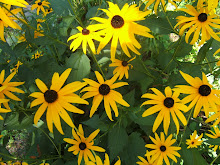Sun shines through the Swiss chard leaves echoing some of the stems which are yellow.
I really like the crinkly, wrinkly texture of the Swiss chard and the stems can be so colourful.
Chard is a good substitute for spinach, and it will grow all summer long without bolting or becoming strong tasting.
Red zinnias and kale. The kale makes a great frilly filler.
Ornamental cabbage coordinating with purple alyssum and millet with bronze foliage in the background. When the millet matures, the wild birds will enjoy it.

Bright green curly parsley fits in well with the geraniums and alyssum. I really like the idea of interspersing some edibles in amongst the flowers.






The Swiss Chard in your photos is usually known as Rainbow Chard in the UK. You can certainly eat the leaves like spinach but even better are the stalk and central rib of the leaves which can also be chopped up and cooked too. When you also take into account its decorative properties it's a very versatile plant indeed.
ReplyDeleteI like the idea of planting veggies in amongst the flowers too. It's very attractive.
ReplyDelete